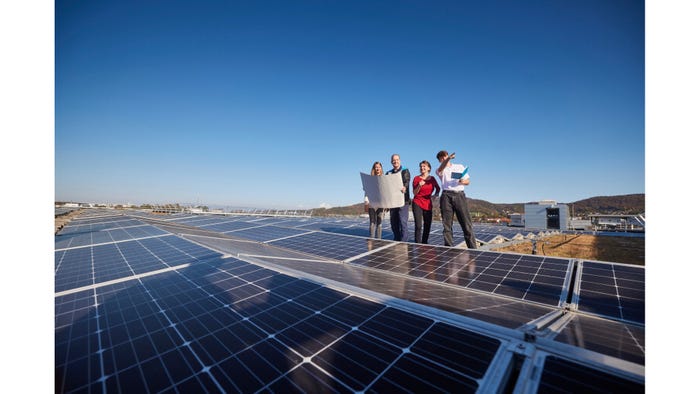Battery Manufacturing Predictions for 2025 and BeyondBattery Manufacturing Predictions for 2025 and Beyond
Lie Shi, CEO of AM Batteries, reveals his forecast for the future of the battery industry.

Battery production hit an all-time high in 2024, especially in battery storage and EV production. According to market research firm Research and Markets, the global market for Electric Vehicle Battery is projected to reach US $84.5 Billion by 2030, growing at a CAGR of 15.5% from 2023 to 2030.
AM Batteries' CEO Lie Shi shares his thoughts on the future of the industry. Shi is a battery industry veteran with more than 25 years of experience working with major players in the global battery automaker and manufacturing landscape. Prior to AM Batteries, he was president of Celgard, a world-renowned battery separator company that invented and commercialized a solvent-free process to produce microporous membranes for lithium-ion batteries.
Battery Industry Forecast 2025
The Inflation Reduction Act (IRA) and the Bipartisan Infrastructure Law (BIL) will endure, despite the uncertainty. First, they are legislatively challenging to dismantle. And second, 75% of the grants have been allocated to Republican districts, with 50% awarded in swing states, ensuring — if somewhat tenuous — bipartisan support.
The US Cleantech sector will undergo a shakeout. (The sector includes industries focused on developing and implementing technologies aimed to minimize negative environmental impacts by promoting energy efficiency, sustainable resource usage, and environmental protection activities). Only the strongest players with true technical differentiation will survive, while those who jumped on the bandwagon without a clear competitive edge will be pushed out in 2025.
Global EV growth will slow, but this could provide a window for adopting next-generation technologies like Sodium-ion, Solid-State Batteries, and Dry Battery Electrode (DBE) technologies.
More battery makers will announce their involvement with Dry Battery Electrode (DBE) technology or committing to its adoption in the near future. This builds on Tesla’s pioneering work in DBE and LG Energy Solution’s plan to commercialize it by 2028.
“Made in America” will become a major theme in the Cleantech space, since the new administration will build physical and financial walls around the US that attract investment in the US.
We spoke with Shi for a more in-depth look at some of the predictions.
Q. Do you foresee that Elon Musk will guide the new administration in more EV production, or otherwise?
Elon Musk has been a driving force in the EV industry, while Trump has been one of its strongest critics. This combination of Musk and Trump seems to create a paradox for the industry. However, I predict increased EV production in the US, driven by Tesla's growth and, more importantly, foreign investments in the US spurred by Trump's tariffs against foreign EVs.
Musk's outsized influence on the new administration may lead to deregulation, fast-track approval, and a surge of Tesla autonomous EVs.
Q. How could the proposed US tariffs work in favor of battery manufacturing?
Tariffs are a double-edged sword. On one hand, it will hurt the supply chain for the EV industry since a significant portion of EV components are sourced from outside the US. These tariffs on Mexico, Canada, and China will sharply increase production costs. On the other hand, the tariffs will encourage US automakers to reply more on domestically sourced parts.
While the tariffs will lead to higher costs for consumers and slow down the adoption of clean technologies, they may encourage Asian countries Japan, Korea, and China to invest in the US. One significant distinction between Trump and Biden regarding Chinese investment in the US is that Trump encourages it, while Biden forbids it. This could lead to increased US production of both batteries and EVs.
Q. What about the production of Li-ion turning to new technologies such as Sodium-ion, Solid-State Batteries, and Dry Battery Electrode?
The growth of EVs is expected to continue, albeit at a slower pace. This slowdown could provide an window of opportunity for the adoption of next-generation battery technologies. Sodium-ion batteries, which use sodium ions instead of lithium ions, are gaining traction due to their abundance and lower cost. Solid-state batteries, which use a solid electrolyte instead of a liquid one, offer higher energy density and improved safety. Both Sodium-ion and Solid-state batteries could potentially benefit from Dry Battery Electrode (DBE) technology, which simplifies the manufacturing process and reduces environmental impact.
Q. Which do you see as the best solution to take the place of Li-ion?
While Li-ion batteries have been the cornerstone of the EV industry and others, emerging technologies like Sodium-ion, Solid-State Batteries, Lithium-sulfur, Flow Batteries, and Hydrogen Fuels are all showing various levels of promise. Sodium-ion batteries are attractive due to the above points, making them a viable alternative. However, the oversupply of Li-ion batteries has greatly depressed their prices, making Sodium-ion batteries less attractive than they were just a couple of years ago. Solid-State Batteries, on the other hand, offer higher energy density and improved safety. However, like Flow Batteries and Fuel Cells, their large-scale commercialization remains a challenge for many major players in the battery world. Ultimately, the best solution will depend on advancements in these technologies and their ability to scale up for mass production.
Q. Did any of your 2024 predictions “ring true” in the year?
Several of my battery industry predictions for 2024 have come to fruition.
The acceleration of funds from the IRA, BIL, and CHIPS Act has indeed supported the CleanTech sector. The adoption of circular economy practices has become essential, with the industry focusing on cleaner and more efficient manufacturing processes for Lithium-ion batteries. EV market growth has faced headwinds such as charging infrastructure, but price parity with fossil-fuel models is within reach. The emergence of strategic alliances and new business models has been key in building the Li-ion battery supply chain, and the commercialization of DBE technology continues to gain momentum.
Q. Can you expand upon your above 5 predictions?
The EV industry will face a dramatically different landscape in 2025 compared to 2024. Over the past four years, government incentives have been instrumental in building a domestic LIB supply chain in the US. However, 2025 will likely see a shift toward new government policies influenced by proposed tariffs and unpredictable actions tied to slogans like “Made in USA” and “MAGA.”
Sustainability will take a back seat, replaced by a focus on deregulation and GDP growth. This shift will create challenges for companies developing new battery or EV technologies, as they may struggle to secure funding and scale their innovations. Cleantech firms that adapt their strategies to align with the evolving political climate in Washington, D.C., will stand a better chance of maintaining support under the new administration.
On a broader scale, these economically driven policies could catalyze the formation of strategic alliances and innovative business models, reflecting the industry's need for collaboration in navigating the complexities of the Li-ion battery supply chain. Proposed tariffs might accelerate joint ventures, potentially involving more Chinese battery and EV manufacturers entering the US market.
About the Author
You May Also Like




